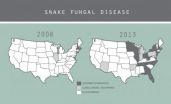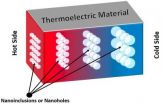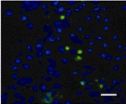NASA sees Typhoon Rammasun's eye staring at Visayas, Philippines
2014-07-15
Early on July 15, Typhoon Rammasun began making landfall in the eastern part of the central Philippines and NASA's Aqua and TRMM satellites spotted the 20 nautical-mile-wide (23 mile/37 km) eye of the storm close to landfall.
Typhoon Rammasun was making landfall in the Visayas region. Visayas is located in the central Philippines.
The Tropical Rainfall Measuring Mission or TRMM satellite passed over Rammasun on Tuesday, July 15, 2014 at 04:10 UTC (12:10 a.m. EDT) and measured rainfall occurring throughout the storm. TRMM found moderate rainfall (about 35 mm)/1.4 inches ...
Scientists gear up to fight deadly snake fungal disease
2014-07-15
CHAMPAIGN, Ill. — Researchers have developed a faster and more accurate way to test for infection with Ophidiomyces ophiodiicola, a fungus that is killing snakes in the Midwest and eastern United States. The test also allows scientists to monitor the progression of the infection in living snakes.
The researchers reported on the test at the 2014 Mycological Society of America Annual Meeting.
"We need people to know that they don't have to anesthetize an animal to collect a biopsy sample or, worse yet, euthanize snakes in order to test for the infection," said University ...
This week from AGU: Dust models, Arctic Ocean waves, floods and climate change
2014-07-15
From AGU's blogs: Global climate models fail to simulate key dust characteristics
Climate models that simulate the airborne African dust that influences Atlantic Ocean hurricanes are not up to the task of accurately representing the characteristics of that dust, according to a new study accepted for publication in Geophysical Research Letters.
From AGU's journals: Surface waves contribute to ice retreat in Beaufort Sea
Surface waves, created by blowing wind, play a role in energy and nutrient transport and also shape coasts through erosion. Because the Arctic Ocean ...
New UK study helps scientists understand melanoma development
2014-07-15
LEXINGTON, Ky. (July 15, 2014) — A new study by University of Kentucky researchers shows how a genetic defect in a specific hormonal pathway may make people more susceptible to developing melanoma, the deadliest type of skin cancer.
Fair-skinned people who tend to burn (rather than tan) from sun exposure have a much higher risk for melanoma than darker-skinned people. On the surface, it appears that the amount of melanin, the natural substance in the skin that determines pigment and acts as the skin's "natural sunscreen," would be the only determinant of melanoma risk. ...
Directly visualizing hydrogen bonds
2014-07-15
WASHINGTON D.C., July 15, 2014 – Using a newly developed, ultrafast femtosecond infrared light source, chemists at the University of Chicago have been able to directly visualize the coordinated vibrations between hydrogen-bonded molecules -- the first time this sort of chemical interaction, which is found in nature everywhere at the molecular level, has been directly visualized. They describe their experimental techniques and observations in The Journal of Chemical Physics, from AIP Publishing.
"These two-dimensional infrared spectroscopy techniques provide a new avenue ...
New feathered predatory fossil sheds light on dinosaur flight
2014-07-15
LOS ANGELES—A new raptorial dinosaur fossil with exceptionally long feathers has provided exciting insights into dinosaur flight. A paper published in Nature Communications on July 15, 2014 asserts that the fossil—discovered by an international team led by Natural History Museum of Los Angeles County (NHM) paleontologist Dr. Luis Chiappe—has a long feathered tail that Chiappe and co-authors believe was instrumental for decreasing descent speed and assuring safe landings.
The 125-million-year-old dinosaur, named Changyuraptor yangi, was found in the Liaoning Province ...
New materials for future green tech devices
2014-07-15
WASHINGTON D.C., July 15, 2014 -- From your hot car to your warm laptop, every machine and device in your life wastes a lot of energy through the loss of heat. But thermoelectric devices, which convert heat to electricity and vice versa, can harness that wasted heat, and possibly provide the green tech energy efficiency that's needed for a sustainable future.
Now, a new study shows how porous substances can act as thermoelectric materials—pointing the way for engineering the use of such materials in thermoelectric devices of the future.
About 70 percent of all the energy ...
Widespread support for rapid HIV testing in dental surgeries -- new study
2014-07-15
More than 80 per cent of oral health patients are willing to receive rapid HIV-testing in dental settings, which could help reduce the spread of the HIV according to a groundbreaking study revealed today at a Sydney University HIV Testing Symposium.
The first of its kind study of 521 Sydney-based dental patients assessed patients' willingness to undergo rapid HIV testing in dental settings, their preference for HIV testing-type type and their willingness to pay for the test.
Rapid HIV testing is a screening test that swiftly detects the presence of HIV antibodies in ...
Hear Jane read: Rutgers University-Newark researcher gives new meaning to semantics
2014-07-15
For years a key way of diagnosing dyslexia has been how well a person reads aloud. Similarly, the reading skills of adult readers also have been assessed by having them read words aloud. "The idea is that the more you read in English, the more you will encounter words that don't follow standard rules of pronunciation, so it's an index of reading exposure and, presumably, ability," explains researcher William W. Graves. But are you a better reader if you pronounce a word based on its meaning, or based on its spelling? Does it make a difference? And why? Those are the ...
Genetic testing for alcohol dependence risk in African Americans
2014-07-15
New Rochelle, NY, July 15, 2014—Alcohol dependence (AD) has a genetic component and testing can determine a person's genetic risk for susceptibility to AD. A new study shows that while more than 85% of the African American adults expressed an interest in genetic testing for AD susceptibility, many had ethical, privacy, and procedural concerns, as reported in Genetic Testing and Molecular Biomarkers, a peer-reviewed journal from Mary Ann Liebert, Inc., publishers. The article is available on the Genetic Testing and Molecular Biomarkers website.
Denise Scott and coauthors ...
New statement on 'PEG' feeding tubes in children published by Journal of Pediatric Gastroenterology
2014-07-15
July 15, 2014– Placement of a percutaneous endoscopic gastrostomy tube has become an "essential" technique for children and young people with a wide range of problems with feeding and nutrition, according to a position statement in the Journal of Pediatric Gastroenterology and Nutrition, official journal of the European Society for Paediatric Gastroenterology, Hepatology and Nutrition (ESPGHAN) and the North American Society for Pediatric Gastroenterology, Hepatology and Nutrition. The journal is published by Lippincott Williams & Wilkins, a part of Wolters Kluwer Health. ...
Identifying newly diagnosed HIV-infected people using electronic medical records
2014-07-15
New Rochelle, NY, July 15, 2014—A new, validated software-based method for identifying patients with newly diagnosed HIV using electronic medical records (EMRs) is described in AIDS Research and Human Retroviruses, a peer-reviewed journal published by Mary Ann Liebert, Inc., publishers. The article is available free on the AIDS Research and Human Retroviruses website at http://online.liebertpub.com/doi/full/10.1089/aid.2013.0287 until August 15, 2014.
Providing medical care early on to people with newly diagnosed HIV infection is important for improving clinical outcomes. ...
Researchers find organic pollutants not factor in turtle tumor disease
2014-07-15
For nearly four decades, scientists have suspected that persistent organic pollutants (POPs) contributed to a green turtle's susceptibility to the virus that causes fibropapilomatosis (FP), a disease that forms large benign tumors that can inhibit the animal's sight, mobility and feeding ability. In a new study,* researchers from the Hollings Marine Laboratory (HML), a government-university partner facility in Charleston, S.C., and from university and federal collaborators in Hawaii demonstrated POPs are not, in fact, a co-factor linked to the increasing number of green ...
Experts voice concerns over arsenic in rice, reports Journal of Pediatric Gastroenterology and Nutrition
2014-07-15
July 15, 2014 – Inorganic arsenic in rice and rice-based foods poses health concerns in infants and young children, and steps should be taken to minimize exposure, according to a commentary in the Journal of Pediatric Gastroenterology and Nutrition, official journal of the European Society for Paediatric Gastroenterology, Hepatology and Nutrition (ESPGHAN) and the North American Society for Pediatric Gastroenterology, Hepatology and Nutrition. The journal is published by Lippincott Williams & Wilkins, a part of Wolters Kluwer Health.
The inorganic arsenic levels ...
Oetzi's 'non-human' DNA
2014-07-15
Much of what we know about Oetzi – for example what he looked like or that he suffered from lactose intolerance – stems from a tiny bone sample which allowed the decoding of his genetic make-up. Now, however, the team of scientists have examined more closely the part of the sample consisting of non-human DNA. "What is new is that we did not carry out a directed DNA analysis but rather investigated the whole spectrum of DNA to better understand which organisms are in this sample and what is their potential function", is how Frank Maixner, from the EURAC Institute for Mummies ...
New mite species from a Caribbean mesophotic coral ecosystem named after J.Lo
2014-07-15
During a recent survey of organisms collected from Bajo de Sico, a mesophotic coral reef ecosystem in Mona Passage off Puerto Rico, one pontarachnid mite species new to science was discovered. The new species was named after the famous Puerto Rican singer Jennifer Lopez. The study was published in the open access journal ZooKeys.
"The reason behind the unusual choice of name for the new species", explains the lead author Vladimir Pešić, Department of Biology, University of Montenegro, "is that J.Lo's songs and videos kept the team in a continuous good mood when writing ...
Hidden variations in neuronal networks may explain differences in brain injury outcomes
2014-07-15
ATLANTA–A team of researchers at the Neuroscience Institute at Georgia State University has discovered that hidden differences in the properties of neural circuits can account for whether animals are behaviorally susceptible to brain injury. These results could have implications for the treatment of brain trauma.
People vary in their responses to stroke and trauma, which impedes the ability of physicians to predict patient outcomes. Damage to the brain and nervous system can lead to severe disabilities, including epilepsy and cognitive impairment.
If doctors could ...
Hidden variations in neuronal networks may explain traumatic brain injury outcomes
2014-07-15
A team of researchers at the Neuroscience Institute at Georgia State University has discovered that hidden differences in the properties of neural circuits can account for whether animals are behaviorally susceptible to brain injury. These results could have implications for the treatment of brain trauma.
People vary in their responses to stroke and trauma, which impedes the ability of physicians to predict patient outcomes. Damage to the brain and nervous system can lead to severe disabilities, including epilepsy and cognitive impairment.
If doctors could predict ...
To accept or not accept -- Patients want a say in liver transplant decisions
2014-07-15
A novel study reveals that more than half of liver transplant patients want to be informed of donor risk at the time a liver is offered for transplantation. Nearly 80% of those patients want to be involved in the decision of whether or not to accept the organ according to findings published in Liver Transplantation, a journal of the American Association for the Study of Liver Diseases and the International Liver Transplantation Society.
There is a shortage of available donor organs, which leaves many on the liver transplant waiting list. Currently, there are more than ...
Cardiac patients underserved globally due to lack of rehab programs: York University researcher
2014-07-15
TORONTO, July 15, 2014 — Rehabilitation programs must become an integral part of cardiac care to significantly reduce the burden of living with heart disease, one of the most common chronic diseases and causes of death globally, according to York University Professor Sherry Grace.
"Cardiac rehabilitation is a cost-effective program offering heart patients exercise, education and risk reduction," says Grace, noting that participation results in 25 per cent less death, lower re-hospitalization rates and better quality of life.
Despite these benefits, cardiac rehabilitation ...
Neuropeptide Y protects cerebral cortical neurons
2014-07-15
Neuropeptide Y exhibits neuroprotective effects. Whether the neuroprotective effects are mediated by the pathways including regulating the immunological activity of reactive microglia and reducing cytokines remains unclear. Prof. Wenqing Zhao, Graduate School, Heibei Medical University, China and his team confirmed that neuropeptide Y prevented excessive production of interleukin-1β and tumor necrosis factor-α by inhibiting microglial reactivity, reduced N-methyl-D-aspartate current in rat cortical neurons, preventing excitotoxicity, and thereby protecting neurons. ...
Hippocampal neuron-related factor expression and neuronal injury after TBI
2014-07-15
Traumatic brain injury (TBI) causes gene expression changes in different brain regions. Cyclooxygenase-2, glutamate receptor-2, and platelet activating factor receptor expression levels are related to the occurrence and development of TBI. However, the precise relationship between the expression levels of these three factors and neuronal injury after TBI remains poorly understood. Zhiqiang Li, Inner Mongolia Corps Hospital, Chinese People's Armed Police Forces, China performed a study and showed that sequential expression of cyclooxygenase-2, glutamate receptor-2, and platelet ...
Signaling pathway for ginsenoside Rb1 promoting hippocampal neuronal neurite outgrowth
2014-07-15
The main pathological changes of Alzheimer's disease (AD) include amyloid-beta protein-induced hippocampal neuronal injury and neurite outgrowth impairment. Phosphatidylinositol 3-kinase (PI3K)/Akt pathway and mitogen-activated protein kinase (MAPK) pathway are the important signaling pathways respectively responsible for regulating synaptic plasticity and neuronal survival. In view of the fact that ginsenoside Rb1 exhibits anti-aging and anti-dementia effects, Prof. Qionglan Yuan and her team, Department of Anatomy & Neurobiology, Tongji University School of Medicine, ...
The ADC does not reflect cytotoxic edema on the uninjured side after TBI
2014-07-15
It is currently difficult to treat traumatic brain injury (TBI) in the clinic. There are abundant neural network connections and humoral regulation mechanisms between the cerebral hemispheres. Brain tissue on the uninjured side after TBI may also undergo abnormal changes, but these changes remain poorly understood. Hong Lu and her team, Affiliated Haikou Hospital, Xiangya School of Medicine, Central South University, in China performed a study to investigate whether apparent diffusion coefficient (ADC) measurements can reflect cytotoxic edema on the uninjured side using ...
Protective effect of α-synuclein knockdown on dopaminergic neurons
2014-07-15
The over-expression of α-synuclein is a major factor in the death of dopaminergic neurons in a methamphetamine-induced model of Parkinson's disease (PD). Dr. Huijun Wang, School of Basic Medical Sciences, Southern Medical University, China and his team injected α-synuclein-shRNA lentivirus stereotaxically into the right striatum of experimental rats to inhibit α-synuclein mRNA and protein expression. Results showed that after α-synuclein knockdown, the depression manifestations of PD rats were reduced, striatal dopamine and tyrosine hydroxylase levels ...
[1] ... [3358]
[3359]
[3360]
[3361]
[3362]
[3363]
[3364]
[3365]
3366
[3367]
[3368]
[3369]
[3370]
[3371]
[3372]
[3373]
[3374]
... [8702]
Press-News.org - Free Press Release Distribution service.














